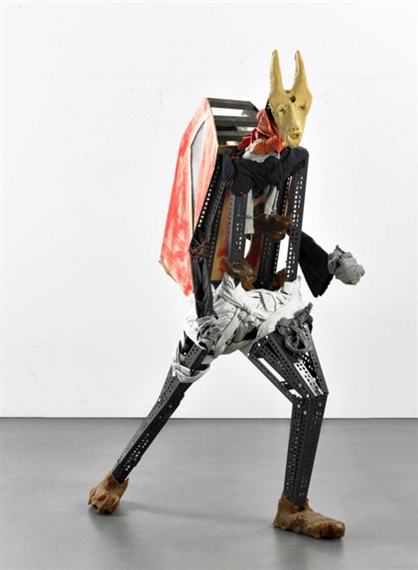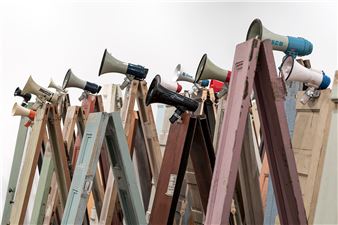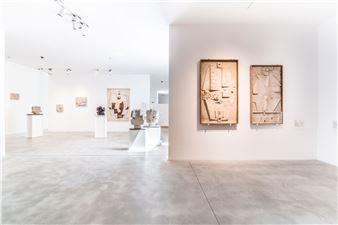Martin Disler: Bilder vom Maler
With large paintings and prints from the estate, as well as a selection of terracotta sculptures and the sculpture HoffnungstrГӨger, the Kunsthalle Bielefeld presents the work of Swiss artist Martin Disler.
Martin Disler was born on March 1, 1949, in Seewen in the canton of Solothurn, Switzerland, and died in 1996 at the age of just 46. Starting as an self-taught author and artist, he became a celebrated star on the national and international art scene after 1980 and was also successful in the art market. One reason for his success was doubtless the worldwide boom in the strongly subjective art labeled Neue Wilde, Transavantguardia, and Figuration libre, although Disler never felt as if he belonged to these contexts. His national and international breakthrough came with the exhibition Invasion durch eine falsche Sprache at the Kunsthalle Basel in 1980. He describes his experiences before and after this exhibition in his book, Bilder vom Maler (Paintings by the painter), the supposedly authentic confessions of a contemporary artist, which was so popular that it was reprinted twice within the first three years of its release. The exhibitionвҖҷs title, Martin Disler. Bilder vom Maler, is a reference to this text, written in 1980.
The show presents works from various phases of DislerвҖҷs career. Some of them were also shown in the famous exhibition, Invasion durch eine falsche Sprache, such as the two drawings Mamma Grottino (1979). DislerвҖҷs early paintings are large canvases with rapidly applied acrylics and clearly recognizable motifs, the free combinations of which are surprising. Strong colors and sprawling surfaces dominate DislerвҖҷs paintings from this period. The succinct motifs and manner of painting heighten their already forceful, captivating immediacy. In terms of painting, DislerвҖҷs later paintings are more ambitious and it becomes more difficult to recognize figurative motifs, even though Disler never entirely gave up figuration. Besides their size, the paintingsвҖҷ extraordinary dynamics and power also stem from DislerвҖҷs process of painting; here, he made use of brushes, as well as his hands and fingers, to apply the paintвҖ”only to scrape it off again with a knife, comparable to working on a sculpture. Disler felt out his paintings, shaping them very physically, in a process of continuous condensation.

Recommended for you
With large paintings and prints from the estate, as well as a selection of terracotta sculptures and the sculpture HoffnungstrГӨger, the Kunsthalle Bielefeld presents the work of Swiss artist Martin Disler.
Martin Disler was born on March 1, 1949, in Seewen in the canton of Solothurn, Switzerland, and died in 1996 at the age of just 46. Starting as an self-taught author and artist, he became a celebrated star on the national and international art scene after 1980 and was also successful in the art market. One reason for his success was doubtless the worldwide boom in the strongly subjective art labeled Neue Wilde, Transavantguardia, and Figuration libre, although Disler never felt as if he belonged to these contexts. His national and international breakthrough came with the exhibition Invasion durch eine falsche Sprache at the Kunsthalle Basel in 1980. He describes his experiences before and after this exhibition in his book, Bilder vom Maler (Paintings by the painter), the supposedly authentic confessions of a contemporary artist, which was so popular that it was reprinted twice within the first three years of its release. The exhibitionвҖҷs title, Martin Disler. Bilder vom Maler, is a reference to this text, written in 1980.
The show presents works from various phases of DislerвҖҷs career. Some of them were also shown in the famous exhibition, Invasion durch eine falsche Sprache, such as the two drawings Mamma Grottino (1979). DislerвҖҷs early paintings are large canvases with rapidly applied acrylics and clearly recognizable motifs, the free combinations of which are surprising. Strong colors and sprawling surfaces dominate DislerвҖҷs paintings from this period. The succinct motifs and manner of painting heighten their already forceful, captivating immediacy. In terms of painting, DislerвҖҷs later paintings are more ambitious and it becomes more difficult to recognize figurative motifs, even though Disler never entirely gave up figuration. Besides their size, the paintingsвҖҷ extraordinary dynamics and power also stem from DislerвҖҷs process of painting; here, he made use of brushes, as well as his hands and fingers, to apply the paintвҖ”only to scrape it off again with a knife, comparable to working on a sculpture. Disler felt out his paintings, shaping them very physically, in a process of continuous condensation.

 ARTISTS
ARTISTS













